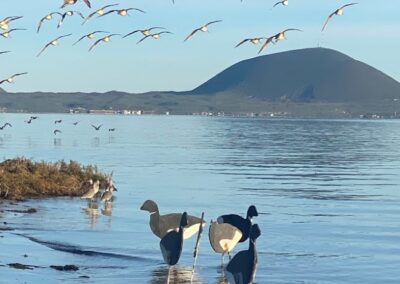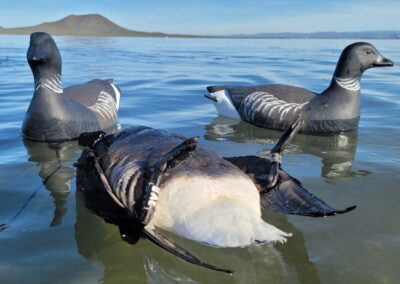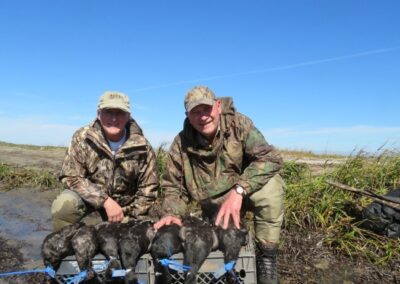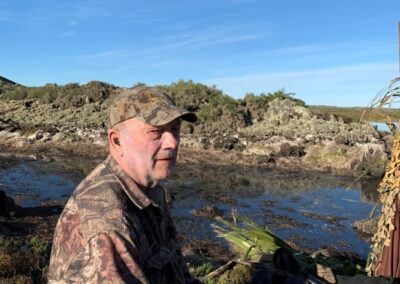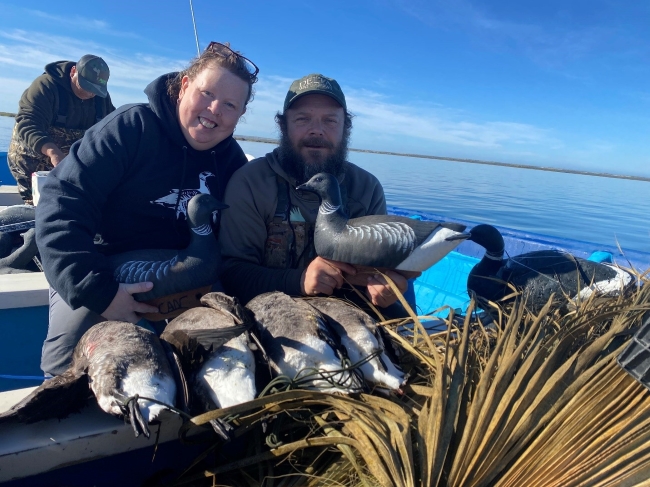
Pursuing Black Brant on the Baja Peninsula
Spring 2024: March 22, 2024
By: Jim Sedinger, Chris Nicolai and Graig Spolek
Twenty plus year old brant with two of Chris Nicolai’s decoys. Photo by Chris Nicolai.
It’s 10 am Sunday and our guide is moving us from a lava blind on the northern end of Bahia Falsa, a western extension of Bahia San Quintin, to a blind at a grit site on the spit forming the southern end of the bay. As we pass multiple oyster operations, we flush flock after flock of brant, thousands of birds. Hundreds of cormorants and gulls roost on floating docks. Surf and white-winged scoters dot the surface of the bay. Western grebes are everywhere. There is the odd pintail (earlier in the morning a helicopter flushed hundreds of otherwise invisible pintails from flooded marsh near our lava blind). I said to my friend Graig, this is the bird version of the Serengeti. As our guide pulled into shore and set us up several hundred long-billed curlews flushed about 50 yards down the shore. These birds continued to do their shore bird thing, flushing and swirling in a cloud of synchronized motion, during our entire one-hour stay at the blind.
This trip began at a Nevada Waterfowl Association Board meeting in November 2023 at a pizza joint in Fernley when Bill Henry mentioned to me that he and Chris Nicolai weren’t going to Baja in 2024 so a couple of spots had opened up. Was I interested? I responded hell yes! Only sixteen hunters are allowed to hunt San Quintin on any given weekend during the season. Hunting is limited to Friday, Saturday and Sunday to allow the birds several days without disturbance so they can feed and restore the fat and protein they will need to fuel migration back to their breeding grounds in the Arctic, and the nutrients required for breeding itself. The next day Bill sent me Gary Kramer’s contact information, and I got in touch with Gary immediately.
Graig and I have been friends since our first year of college in the 1960s. Graig, a long serving past president of the Oregon Duck Hunters Association, hunts ducks every week of the Oregon season but he has never hunted brant so I thought he might be interested. Sure, enough he was, and Gary indicated there was still a spot open, which Graig immediately snapped up. So, we were both in, with plans to meet in San Diego on the evening of January 24. Chris later decided he would go after all and his wife Amy accompanied him.
Graig and I met Chris and Amy Nicolai, and Phil Jebbia for dinner in San Diego. Phil is a long-time (30+ years) brant hunter and supporter of the Tutakoke River Black Brant research project. Some of you may be familiar with the heart-warming story by Chris about Phil shooting a color-banded brant that he had a picture of on his wall. We had a great dinner, after which, Chris presented Phil with a beautiful ring neck decoy, similar to the one that was auctioned for $1,500 at NWA’s dinner last August.
The next morning, we met the rest of our party at the San Diego airport and two drivers soon loaded us up and we set off for the Old Mill motel on the shore of San Quintin Bay. After stopping for a lobster lunch, we arrived at the Old Mill a little after 6 pm. Everybody was in bed early for an early start the next day.
The following day, we met the guides at the dock in the dark and headed off for various spots around the bay. Each guide transported two hunters. That first morning a short boat trip transported us to our shore blind within site of the Old Mill. We got set up with a couple of strings of decoys and a simple blind. Graig and I had some coffee and small homemade breakfast burritos our guide had brought, and waited for brant. The first couple of hours were pretty slow but we could hear shooting on other parts of the Bay. Eventually, a flock of brant came into the decoys; Graig knocked down two birds and I one. Graig finished his limit in the next couple of hours but I still needed two birds to fill my four-bird bag. At about 10:30 our guide moved us to a different shore blind just across the bay. Few birds were moving, but at 11:57, three minutes before shooting ended, a group of birds came into the decoys and I shot two, a Scotch double, and we were finished. Graig and I were the last ones in, everybody had a limit on day one. After a late breakfast, we joined four others for a quail hunt in the hills. Tough going for me; imagine California chaparral with cactus filling every void in the chaparral plants. That’s where the birds were. The rest of the crew relaxed, ate some fresh oysters, and otherwise enjoyed themselves. Chris had brant appetizers on the grill when we got back to the Old Mill. If you haven’t eaten Black Brant you’re missing the best eating waterfowl in North America.
Chris hunted in a different spot on the first day. That day he shot a bird with a plastic tarsal band that he had rolled at the Tutakoke field camp in 2006. The bird was at least 20 years old. To add to the story, he shot the bird over two new decoys that contained the ashes of one of his beloved labs, Berni, who was named for brant (bernicla) and had retrieved many brant in Alaska, Washington, and all bays in California.
The next morning our guide boated us to a blind on the spit that forms the western boundary of the bay and separates it from the breakers on the Pacific Ocean. As on day one, we were set up on a grit site. Because brant are in the water more than 20 hours a day they take the opportunity to come into shore on the falling tide to get out of the water, preen their feathers and obtain grit, which they store in their gizzards and use to help grind up their plant foods. Brant feed mostly on eelgrass, a submerged aquatic plant and at high tide much of the eelgrass is out of reach. So, when eelgrass is still out of reach, and as grit becomes exposed on the falling tide they take the opportunity to meet some of their other daily needs. Tides were fairly high in the morning on the weekend we were in San Quintin so shooting was a little slower on grit sites than it can be. Graig and I both had a couple of birds mid-morning that second day and our guide moved us to a rock blind just a few hundred yards to the north. The pair at this blind had already limited out.
The new blind was a rock blind, formed by a small wall of lava. On the northern shore of San Quintin three small volcanoes separate two long arms that extend north from the main body of the bay. Lave fields extend right to the shore of the bay. The rock blinds are adjacent to deeper water filled with eelgrass, so these blinds are spots where birds come into feed. We both limited out in the next hour and were headed back to the Old Mill by 11 in the morning.
Saturday evening the guides prepared a feast for us. Oysters on the half shell from local farms. Tamales filled with spicy brant meat. Grilled brant breasts and legs followed, finished off with grilled lobster. It was a great evening. We met Arturo who runs Baja hunting and Tiburon who manages the guides and fishing charters.
Sunday hunts were a little truncated because part of the group had to be back in San Diego for 8:30 pm flights. Graig shot three brant on Sunday but I was skunked. Chris and Amy Nicolai were set up just a couple hundred yards down the shore from our second spot. Chris hadn’t had a shot all morning, when a flock came in and he shot four birds. We headed back to the Old Mill around 11 with the Nicolais just ahead of us. And while the last morning was slower, we had had three spectacular days on the bay. I have spent 40 years of my life studying brant on their breeding grounds. They are special birds, that form tight social bonds (the main reason they decoy so well), each with its own personality. And, of course, they are spectacular eating. It was a real treat to see them again in winter. Overall, the group shot about 160 brant for the weekend. Eleven of the birds were banded, most from my long-term study site on the Bering Sea Coast of Alaska.
Hunting brant in Mexico could be a once-in-a-lifetime experience but I plan to go back in two years.
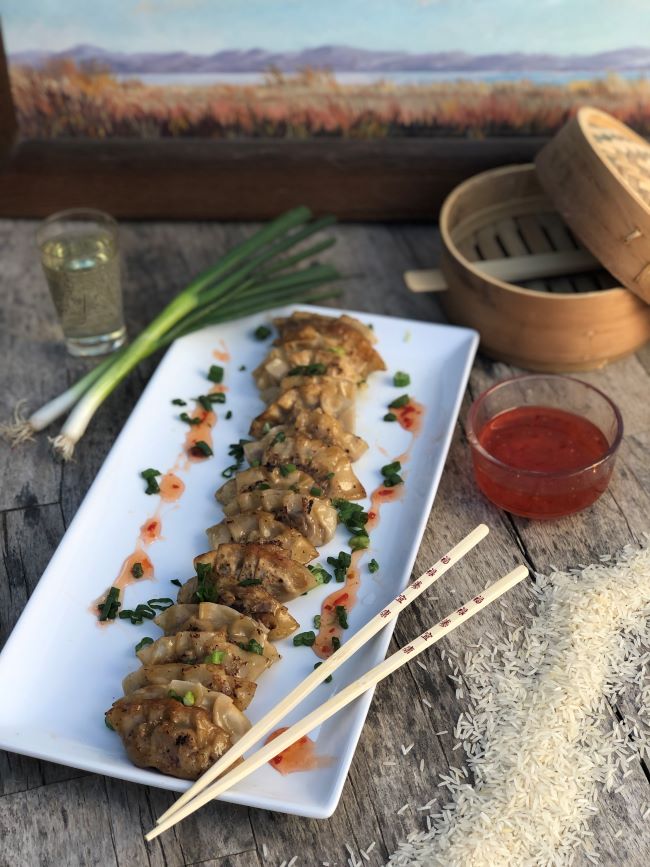
RECIPE CARD-Goose Potstickers
Submitted by: Nevada Foodies
A delicious dumpling filled with a blend of wild goose, crunchy water chestnuts, onions, garlic, fresh grated ginger, and other flavorful ingredients. Chop, pulse and fill the aromatic meat mixture into each individual wrapper for a mouthwatering appetizer or an Asian inspired dinner.
If you don’t have goose meat on hand, you can substitute with wild duck as the main source of protein.
Prep Time: 30 minutes
Cook Time: 20 minutes
Servings: 6
Ingredients
• 2 boneless skinless goose breasts, roughly chopped
• 8 oz water chestnuts, chopped
• 1/2 cup red bell pepper, chopped
• 2 green onions, chopped
• 1 shallot, chopped
• 2 garlic cloves, minced
• 2 tbsp fresh ginger, chopped
• 2 tbsp hoison sauce
• 2 tbsp soy sauce
• 1 tbsp rice vinegar
• 1 package round pot sticker wrappers
• 1/2 cup vegetable oil for frying
• 1 cup chicken stock Instructions
1. Add chopped goose meat, water chestnuts, red bell pepper, green onions, shallot, garlic, ginger, hoison sauce, soy sauce and rice vinegar to a food processor. Process until a fine stuffing is formed. Refrigerate for an hour.
2. To form the dumplings, remove 1 wrapper from the package, covering the others with a damp towel. Moisten the edges of the wrapper lightly with water. Place a rounded teaspoon of the stuffing in the center of the wrapper. Fold over, seal edges, and shape as desired. Set them on a sheet pan and cover with a damp towel. Repeat the procedure until all the filling is gone.
3. Heat a skillet over medium heat and add a few tablespoons of oil to the skillet. Place about 8-10 potstickers into the pan, flat side down and cook for 2 minutes. Once the 2 minutes are up, carefully add a little chicken stock to the pan, turn the heat down to low, cover, and steam for another 2 minutes. Remove to a heatproof platter and place in the warm oven. Repeat with the remaining potstickers.
4. Garnish with chopped green onion and serve with sweet heat chili sauce.


